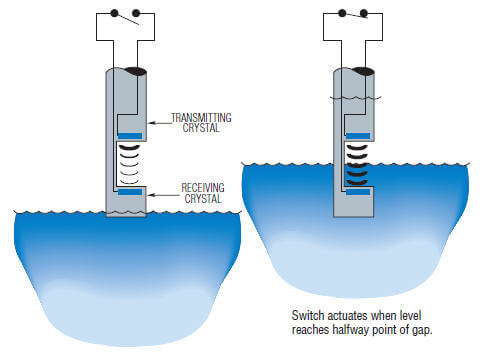Ship liquid level switches have two more requirements than ordinary water level switches. One is corrosion resistance, because seawater has high salinity and is corrosive to a certain extent. The second is to be able to prevent waves. The ship shakes violently while driving, and the water in the water tank fluctuates greatly. A water level switch with anti-wave function is needed to prevent the switch from being turned on and off frequently. Third, it can prevent interference from obstacles and floating debris. The main functions of the marine water level switch are: first, as a bilge water level alarm, which can be used to alarm the water level in the bilges of various types of ships. The second is to drive other equipment to move, such as a water pump. When the water is full to a certain level, the water pump starts to pump out the water, etc.
Principle: Ultrasonic liquid level sensor/level gauge is composed of a complete ultrasonic sensor and control circuit. The ultrasonic waves emitted by the ultrasonic sensor are reflected by the liquid surface, and the time required for return is calculated. The temperature effect during the ultrasonic transmission process is corrected by the temperature sensor, and converted into the distance between the liquid surface and the ultrasonic sensor. The liquid crystal displays and outputs 4mA- 20mA DC analog signal enables remote reading of field instruments.
The fork-shaped probe of the piezoelectric crystal inside the ultrasonic liquid level switch is separated by air. A crystal with a vibration frequency of 1.5MHz transmits the sound signal to the middle of the air gap. When the probe is immersed in the liquid, the crystal and sound waves couple, and the ultrasonic liquid level switch changes state. 
Advantages: Ultrasonic liquid level sensor is a non-contact measurement method, with ±0.2% accuracy, 1-5 meter range, excellent focus: 5-degree sound beam angle, multiple sensor materials, and built-in full-scale temperature compensation. Ultrasonic liquid level sensor measures corrosive (acid, alkali) media, polluted occasions, or substances that are prone to adherents. Suitable for liquids that cannot be physically touched.
Disadvantages:
1: It is related to the viscosity of the measured medium. It cannot be measured when the viscosity of the measured medium is large;
2: Affected by temperature, when the temperature is high, the propagation speed will change, the instrument will respond slowly, and the alarm will be delayed.

 CN
CN


